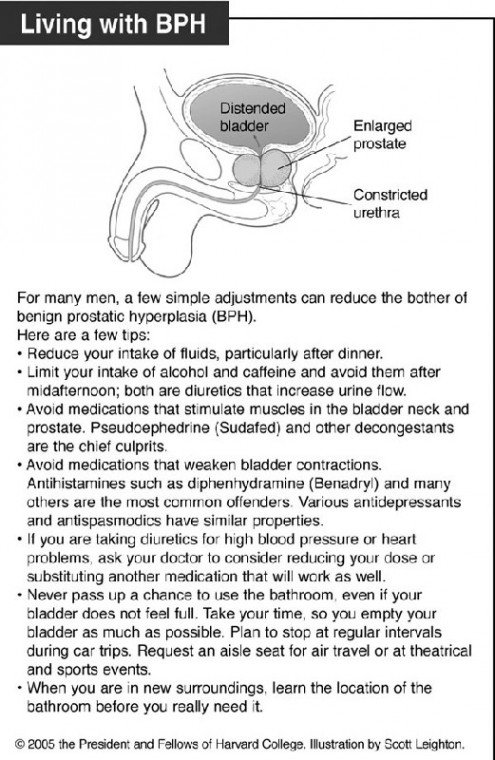Q: I’ve been losing sleep because I need to get up to urinate
several times a night. My doctor says I probably have an enlarged
prostate. What medications can I take for this problem?
Q: I’ve been losing sleep because I need to get up to urinate several times a night. My doctor says I probably have an enlarged prostate. What medications can I take for this problem?
A: Fortunately, there are a number of medicines to treat benign prostatic hyperplasia, or BPH. To explain how they work, we need to first to describe the problem.
The prostate is a walnut-sized gland that sits under a man’s bladder. It completely surrounds the urethra, the tube through which urine flows from the bladder out through the penis.
If the prostate enlarges – a common problem in older men – urine doesn’t flow as easily. Common symptoms include a weak, slow urinary stream, hesitancy and straining to urinate, and dribbling at the end of urination.
Some men also feel as though they can’t fully empty their bladders. They may also have an urgent, sometimes uncontrollable need to void. Frequent nighttime urination is another typical symptom.
Many men with mild to moderate symptoms can manage BPH themselves with simple lifestyle adjustments. Others may decide to try herbal preparations such as saw palmetto. But if your symptoms still bother you, effective drug treatments are available.
Doctors can use two very different types of drugs to treat BPH. One class is known as alpha blockers.
They don’t change the size or structure of the prostate. Instead, they relax the smooth muscle cells in the bladder neck and in the prostate itself.
As the muscles relax, pressure on the urethra drops, allowing urine to flow more freely.
About 70 percent of men with BPH find they get mild to moderate relief from their symptoms within days of starting an alpha blocker.
All the alpha blockers work the same way, and all have similar success rates. But they do have different side effects and drug interactions.
Older alpha blockers, such as terazosin (Hytrin) and doxazosin (Cardura), were originally used to treat high blood pressure.
They relax muscles in the artery walls as well as the bladder neck and prostate.
Because they lower blood pressure, these drugs can cause lightheadedness, dizziness or even fainting, particularly if you stand up quickly. It also means that men who have somewhat low blood pressure or who are already taking other medications for high blood pressure should use them with caution.
The third alpha-blocker, tamsulosin (Flomax), is a selective alpha-blocker.
That means it’s more active on the prostate and bladder than the arteries, so it’s much less likely to lower blood pressure. The same is true for the newest alpha-blocker for BPH, alfuzosin (Uroxatral).
Its major advantage is that it appears less likely to cause diminished or “dry” ejaculation, a problem for some men taking tamsulosin. The most common side effect is dizziness, which occurs in about 5 percent of men who take it.
Unlike the alpha-blockers, the second group of drugs for BPH actually shrinks the gland. These drugs include finasteride (Proscar) and dutasteride (Avodart).
Both work by blocking an enzyme that changes testosterone to a related chemical called DHT, the main male hormone in the prostate. The lowered DHT levels cause the prostate to shrink gradually, usually within three to six months.
Although finasteride reduces the size of the prostate in most men, it relieves symptoms for only about a third of men with BPH.
Men with the largest prostates tend to benefit the most. And because doctors can estimate the size of a man’s prostate, they can predict which men are likely to be helped. In general, men with glands smaller than 30 to 40 milliliters (ml) don’t improve with finasteride.
Dutasteride appears to be just as effective as finasteride, and both are equally safe.
Impotence is the only major side effect, but it develops in just 4 percent to 5 percent of men, and it diminishes when treatment is discontinued.
Unlike the alpha-blockers, both drugs lower prostate specific antigen levels by about 50 percent.
PSA levels are used to screen for prostate cancer. Men who choose to monitor their PSAs should take the test before starting the drug and after 6 to 12 months of therapy.
For years, BPH has been recognized as a common problem for older men. Fortunately, today there are treatments that can reduce or even eliminate its bothersome symptoms.
Submit questions to the Harvard Medical School Adviser at www.health.harvard.edu/adviser. Unfortunately, personal responses are not possible.













